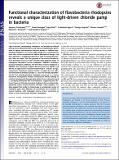Functional characterization of flavobacteria rhodopsins reveals a unique class of light-driven chloride pump in bacteria
Author(s)
Yoshizawa, Susumu; Kumagai, Yohei; Kim, Hana; Ogura, Yoshitoshi; Hayashi, Tetsuya; Iwasaki, Wataru; DeLong, Edward; Kogure, Kazuhiro; ... Show more Show less
DownloadYoshizawa-2014-Functional character.pdf (892.4Kb)
PUBLISHER_POLICY
Publisher Policy
Article is made available in accordance with the publisher's policy and may be subject to US copyright law. Please refer to the publisher's site for terms of use.
Terms of use
Metadata
Show full item recordAbstract
Light-activated, ion-pumping rhodopsins are broadly distributed among many different bacteria and archaea inhabiting the photic zone of aquatic environments. Bacterial proton- or sodium-translocating rhodopsins can convert light energy into a chemiosmotic force that can be converted into cellular biochemical energy, and thus represent a widespread alternative form of photoheterotrophy. Here we report that the genome of the marine flavobacterium Nonlabens marinus S1-08T encodes three different types of rhodopsins: Nonlabens marinus rhodopsin 1 (NM-R1), Nonlabens marinus rhodopsin 2 (NM-R2), and Nonlabens marinus rhodopsin 3 (NM-R3). Our functional analysis demonstrated that NM-R1 and NM-R2 are light-driven outward-translocating H+ and Na+ pumps, respectively. Functional analyses further revealed that the light-activated NM-R3 rhodopsin pumps Cl− ions into the cell, representing the first chloride-pumping rhodopsin uncovered in a marine bacterium. Phylogenetic analysis revealed that NM-R3 belongs to a distinct phylogenetic lineage quite distant from archaeal inward Cl−-pumping rhodopsins like halorhodopsin, suggesting that different types of chloride-pumping rhodopsins have evolved independently within marine bacterial lineages. Taken together, our data suggest that similar to haloarchaea, a considerable variety of rhodopsin types with different ion specificities have evolved in marine bacteria, with individual marine strains containing as many as three functionally different rhodopsins.
Date issued
2014-03Department
Massachusetts Institute of Technology. Department of Biological Engineering; Massachusetts Institute of Technology. Department of Civil and Environmental EngineeringJournal
Proceedings of the National Academy of Sciences
Publisher
National Academy of Sciences (U.S.)
Citation
Yoshizawa, S., Y. Kumagai, H. Kim, Y. Ogura, T. Hayashi, W. Iwasaki, E. F. DeLong, and K. Kogure. “Functional Characterization of Flavobacteria Rhodopsins Reveals a Unique Class of Light-Driven Chloride Pump in Bacteria.” Proceedings of the National Academy of Sciences 111, no. 18 (March 31, 2014): 6732–6737.
Version: Final published version
ISSN
0027-8424
1091-6490